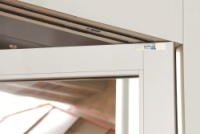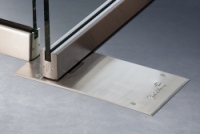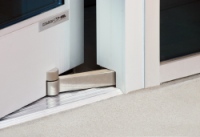Choosing the right door closer for your project is an important task, but it doesn’t have to be an intimidating one. There are many manufacturers and product options in the door closer market, and you must carefully select the best closer that fits the entrance, adequately controls the door, and complies with local and federal building regulations. However, with a few tips and some key insight into door closers, you’ll be ready to make the right decision for your project.
Types of Closers
The most common door closers in the market today are surface mounted, overhead concealed and floor mounted concealed. When choosing the best one for your application, consider these important factors:
- location and type of opening
- interior or exterior mounting
- volume and frequency of door traffic
- type of door
- size and weight of door
- door swing
- wind or building pressure conditions.
Surface mounted door closers are most commonly used since they provide a wide range of features and options that aren’t found on other types of closers. They are available in four variations, including slide-track arm, regular arm surface mounted, parallel arm surface mounted and top jamb mounted. Surface mounted closers are commonly used for aluminum storefront doors and are the best option for low- to-medium traffic entrances. They are also highly economical and fairly easy to install, requiring a minimum of drilling or cutting.
Overhead concealed door closers are best used in medium-to-heavy traffic areas. They are installed and hidden from view inside the headers of storefront doors and frames. Overhead concealed closers can be positioned in center-hung or offset arm positions with narrow, medium, or wide stile doors.
Floor mounted door closers are the most durable, longest lasting option and are necessary when dealing with heavy doors or areas with high to extreme traffic. These high efficiency closers can be easily adjusted and work best in conjunction with tall, wide or substantial storefront doors, especially those made of insulating or heavy glass. Both floor mounted and overhead concealed door closers are always the best option when using all-glass rail or patch-fitted doors, as they offer improved aesthetics with minimal visible hardware. Furthermore, these all-glass applications lack practical mounting options for surface mounted closers.
Features to Consider
Once you’ve selected the right type of door closer for your application, you need to select the optimal spring size, grade and desired features. Is the door located inside or outside? What type of locking device will be used? What type of weather seals will be added to the door? Will the door closer need to overcome any internal building pressures?
The wider or heavier the door is, the larger the spring must be in order to control it. The goal of a good door closer is to open and close the door with a reasonable amount of force. All closers are rated by spring size and are commonly expressed as Size 1, Size 2, Size 3, all the way up to Size 6. Most door closers are a fixed size and can only be used with specific doors. However, door closer manufacturers make springs that can be adjusted to the precise opening and closing force required to control different doors.
Most door closers also consist of independent adjustment valves that control the door’s closing (sweep) and latching speed (last 15 degrees of closing cycle). These valves accelerate the door so it can overcome latching or closing resistance that’s caused by locks, panic devices, seals or internal building pressures. Backcheck is another important feature to consider because it dampens or brakes the door when opening between 75 degrees to 90 degrees to prevent violent swinging and damage to the closer, opening frame and adjacent structures.
As a rule of thumb, never use a door closer as a doorstop. Instead, install an auxiliary doorstop whenever a positive stop is needed. If a stop isn’t used, the door can be overextended past its limited range and will damage the closer and/or the entire storefront door. When thinking about the long term, it’s less expensive to install a positive stop than to repair a door closer or frame that’s been damaged by high wind or heavy foot traffic.
Building Codes and Regulations
Now that we have established the basic fundamentals of door closers, it’s time to take local and federal building codes and regulations into account. Door closer standards and regulations are developed and monitored by the Builders Hardware Manufacturers Association and the American National Standards Institute. The standards contain performance and durability requirements for door closers that must meet Grade 1, 2 or 3 performance criteria. Among other specifications for each grade, door closers are subjected to a “cycle count”:
- Grade 1 = 2,000,000 cycles with a minimum efficiency of 60 percent
- Grade 2 = 1,000,000 cycles with a minimum efficiency of 60 percent
- Grade 3 = 500,000 cycles with a minimum efficiency of 50 percent
For example, high-traffic doors in places such as shopping malls, department stores, and schools or universities are recommended to have closers that have been tested to perform under Grade 1 conditions. If the entryway will experience less frequent usage and isn’t subject to high stress or strong wind conditions, a Grade 2 or 3 is suitable. Make sure to always consider the location and traffic of the door to ensure selection of the best door closer for the job.
In addition to complying with BHMA and ANSI standards, you must adhere to the Americans with Disabilities Act. This code states that disabled individuals will have unimpeded travel through points of entry. Furthermore, ADA stipulates exterior entry doors should have no more than 8 ½ pounds of opening force, while interior doors are limited to 5 pounds. Some states have additional ADA regulations to be mindful of, such as California, which requires that interior and exterior doors be limited to five pounds of opening force.
In complying with ADA regulations, you may come across issues surrounding the efficiency and abilities of door closers in some situations. For instance, undesirable friction that’s created by resistance from opening the door can reduce the door closer’s power by a staggering 50-60 percent. This means that if your door closer is originally designed to provide up to 8 ½ pounds of opening force, your closing force is reduced to about 4-5 pounds. This is often not enough closing force to overcome strong wind conditions, negative air pressure for an HVAC system, or even latching resistance that’s created by most locks and exit devices. In these instances, one way to solve the issue is to use an electric-powered door closer or an automatic door.
Another option is to use a balanced door. This design’s door panels rotate on a rolling pivot on an elliptical path. This provides the widest possible door opening with the smallest swing arc. Balanced doors offer effortless opening and closing by neutralizing two naturally occurring pressures: atmospheric (wind) and interior stack pressure. These door types are usually required for commercial projects with monumental entrances that require oversized, heavy doors to ease use and control of the door. However, select manufacturers are now developing aluminum entrance doors that feature the same balanced mechanics, offering an ADA-compliant entrance for high-traffic conditions that is also economically viable. Staying up to date on your local ADA building codes and requirements will make choosing the best ADA, BHMA and ANSI-approved door closer surprisingly easy.
Regardless of which door closer you choose, it’s important to carefully review and follow the manufacturer’s installation and maintenance instructions. In many cases, when functionality issues arise early on, it is because the door closer was simply installed incorrectly. Doing it right the first time will help you avoid any extra costs, wasted time or grief.
Selecting the right door closer can mean the difference between having a successful or failed project. Paying close attention to both internal and external factors that affect your entrance doors, in addition to installing the closers properly, will produce a more rewarding and profitable outcome for all parties involved. Following these recommendations can also help you to avoid costly repeat service warranty calls and can ultimately lengthen the life of your door and door closers.
 |
 |
|
| Surface mounted closers offer a variety of features in a cost-effective package. Pictured are CRL-U.S. Aluminum Series 400 entrance doors with CRL PR90 Series surface mounted door closers and CRL Jackson 1200 Series panic exit devices. | Hidden inside the door header, overhead concealed closers can withstand medium to heavy traffic. Pictured is the CRL Jackson overhead concealed door closer with a CRL-U.S. Aluminum Durafront Series 800 entrance door. | |
 |
 |
|
| Floor mounted door closers can handle high foot traffic with heavy or insulating glass doors. Pictured is the CRL Jackson 900 Series heavy-duty floor mounted door closer with ‘all glass’ pivoting door featuring CRL Wedge-Lock low-profile door rail and matching sidelite rail. | Balanced doors pivot on an elliptical path that allows for a wide opening with a small swing arc that makes them easy to open. Pictured is the CRL-U.S. Aluminum Balancer Series balanced door. |




